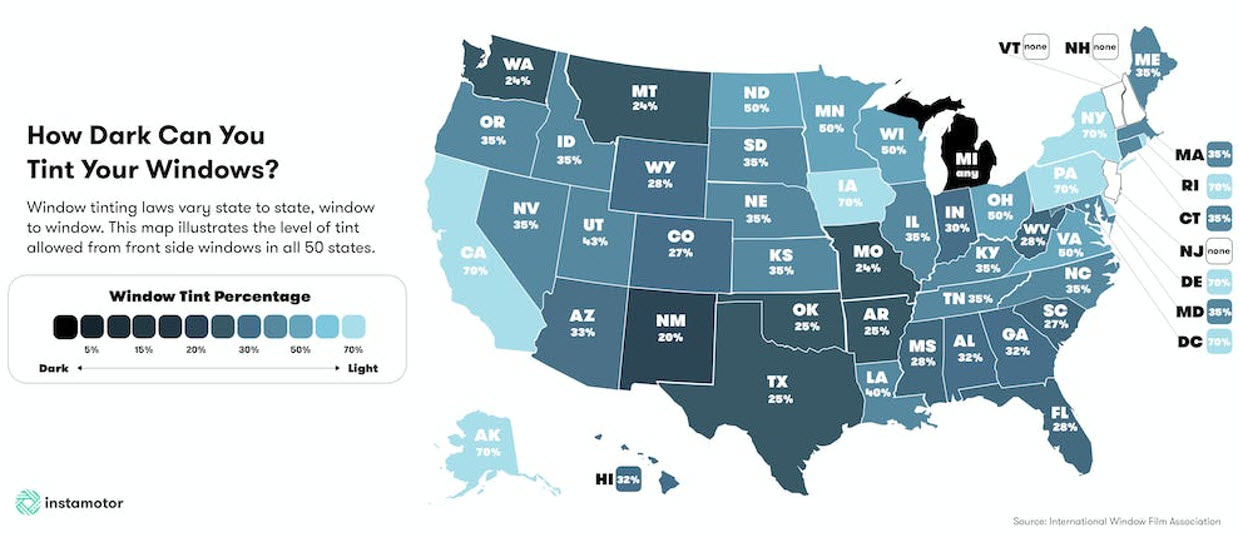WINDOW TINT LAWS IN MARYLAND
Every state has a specific percentage you’re allowed to tint your windows. Most of these limits are light on the scale of darkness, this is so law enforcement can easily see who is inside the vehicle.
Window Tint Laws in Maryland state that you are legally allowed to have 35% VLT (visible light transmission) on your sides and rear windows of any 2-door coupe or 4 door sedan.
Trucks and SUV’s can darken their rear windows as much as they’d like as there isn’t any laws set for the rear windows for trucks and SUV’s. Trucks and SUV’s must still have 35% or above on the two front side roll down windows to pass inspection.
Legally the only tint you’re allowed to have on your windshield is a 5” strip on the top of the glass, this has many nicknames you’ll hear “windshield visor”, “front strip”, “front brow”, all mean the same thing. The front strip is traditionally 5% dark to block as much sunlight possible.

How we make sure you stay legal
Every vehicle on the road has a very light tint on the glass from factory. This is a dye built in the glass, it cannot be removed and is often metered around 70-75% VLT. Because of this very light dye, it can alter the shade of tint you install and can cause your windows to be illegal.
For instance, if we installed a 35% exact tint to your windows, after installation they would meter closer to 30% causing them to be illegal. To combat this, we use XPEL CS 43%, XR 45% and XR+ 45% if you want to stay legal. When you install any of these films, you will safely be around 40% VLT after installation and that would be the darkest you would get without dipping under that 35% mark.
I see other cars on the road with dark window tint, why?
Not everyone abides by the law when it comes to window tinting, some folks will tint their windows extremely dark and simply risk the consequences of getting a repair order or ticket and having to remove your tint. We always suggest staying legal when it comes to darkening your windows, the best part about our XR ceramic tint is you can block 80% of the heat without having to go dark at all.
A few other reasons you might see dark tint on cars driving around, not all states have the same legal limits, in Pennsylvania you’re not allowed to have any window tint, and in Florida you’re allowed to have 28% tint. You may come across a driver from another state, or perhaps someone in Maryland with a medical condition such as skin cancer, sun sensitivity, or glare issues when driving can sometimes get you a medical waiver allowing any darkness to be applied to your vehicle.
Lastly, trucks and SUV’s come from the factory with a 20% dye in the rear windows, because of this, no state can regulate the rear darkness of trucks, SUV’s or anything else that comes with factory rear window tint. When your vehicle has this built into the glass, the dye does not block any heat but does add privacy. Some clients will choose to darken the rear windows or apply a light shade to just block heat.

Terminology
These are the terms you need to know in order to interpret the various state laws and limits.
- VLT%: Visible light transmission is the measurement used to assess automotive window tints. This is the percent of visible light that gets through either the film (film VLT%) or window plus film net VLT%. The lower the VLT%, the darker the tint.
- Front-side window tint level: This is the amount of tint (VLT%) you’re allowed on your driver and front passenger windows. This is frequently a higher value than for the rear, which allows the driver of the vehicle to be seen from outside.
- Rear-side window tint level: This is the amount of tint (VLT%) you’re allowed on your rear side windows. This value is sometimes different for passenger cars and multi-purpose vehicles (MPVs).
- Rear window tint level: This is the amount of tint (VLT%) you’re allowed on your rear window. This value is typically the same as for the rear side windows, but some states are more restrictive.
- Windshield: Your windshield cannot be tinted in any state, but some states allow you to add a sticker to the top of the windshield, usually in the area of the manufacturer’s sun shield.
- Color: The state laws on tint color vary from no restrictions at all to restrictions on the use of certain colors or reflective/mirrored finishes.
- AS-1 Line: This is the line extending from the letters AS-1, found on most motor vehicle windshields, running parallel to the top of the windshield.
